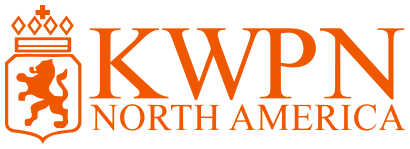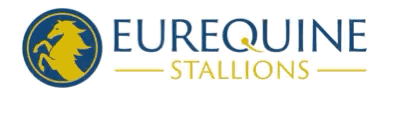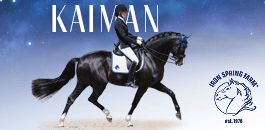The KWPN-NA
FAQs & How To
Transfer of Ownership
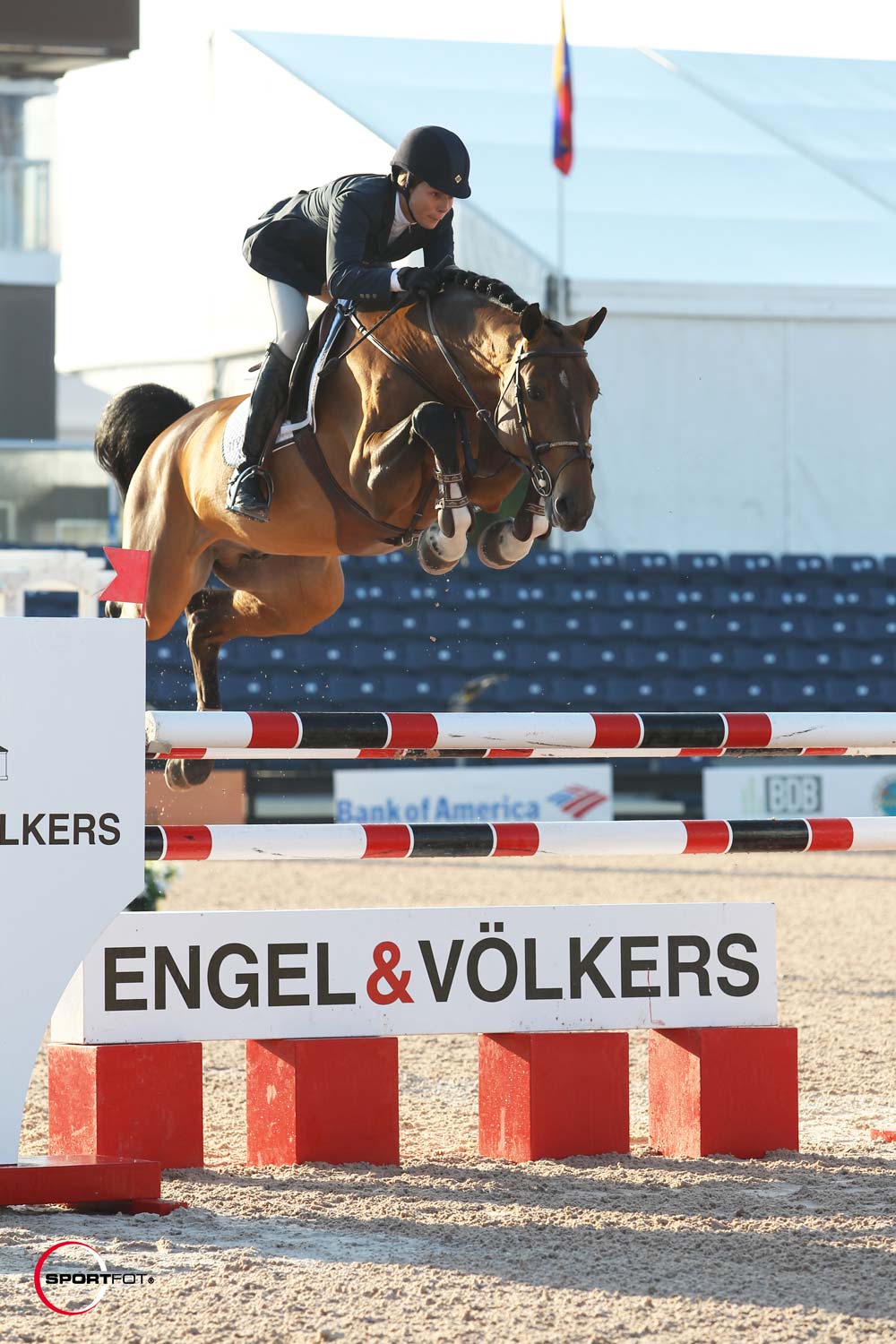
2014 KWPN-NA Horse of the Year
Imothep (Indoctro pref x Serena H by Calvados keur x Dominard), Photo: SportFot
The following are required to transfer the ownership of a horse:
- Original registration papers (and passport if applicable);
- A completed ownership transfer form;
- A Bill of Sale, signed transfer form or other documentation establishing ownership from the last owner recorded with the KWPN. Signature of the previous owner on the transfer form may be used as a Bill of Sale.
- Imported horses being transferred for the first time require three photographs clearly showing all markings for identification purposes.
- A transfer fee of $25 for current full members, $110 if you would like to become a member at the time of the transfer (valid through Dec 31 of that year) OR a one-time non-member transfer fee of $50.
In the case of a newly imported horse and if it is absolutely not possible to obtain a release from the last owner in Holland, please contact the KWPN-NA office about a release from the KWPN. If the KWPN-NA is able to obtain a release for a transfer from the KWPN, it may still be possible to complete the transfer.
(Note: If the previous owner of record signed a Bill of Sale, he/she does not need to sign the transfer form.)
Multiple Owners
If ownership of a horse is listed on the papers as ‘person one’ and ‘person two’ (married or not), both owners will have to sign the bill of sale or the transfer of ownership form. If ownership is listed as ‘person one’ and/or ‘person two,’ either person can sign off on the horse.
Horses Sold by Third Parties
Horses sold through an agent – If a horse is sold through an agent we still need the signature of the owner of record. We need to either have a signed agreement on file giving an agent permission to sell horse(s) for a particular owner or we need a bill of sale signed by the owner of record.
Horses sold through an auction – If a horse is sold through an auction we still need the signature of the owner of record. We need either a signed agreement on file between the auction and the owner of record, or we need a bill of sale signed by the owner of record.
In normal cases it should take about 2–3 weeks for the transfer to be complete and for the papers to be back in your hands. If you have not received your papers after three weeks, please call the KWPN-NA office to inquire. If a year passes without notifying the KWPN-NA office, duplicate papers must be applied for.
Duplicate Papers & Deceased/Insured Horses
Duplicate Papers
If registration papers have been lost or destroyed, an application for duplicate papers may be submitted. The application must include:
- The registered names of the horse, sire and dam with their registration numbers;
- A copy of original registration papers, if possible;
- A minimum of three photographs for identification, clearly showing all markings;
- A hair sample for a DNA test (see parentage verification);
- Explanation of loss must be signed by the owner of record or by the current owner if accompanied by a properly documented paper trail from that last KWPN owner of record;
- The fee for a duplicate paper for a horse that is on file with the KWPN-NA is $300 (includes DNA typing);
- The additional fee for a duplicate KWPN passport is $50.
New papers will be issued if horse identification and ownership is clearly established. Request may be denied if horse identification or ownership is not clearly established. No refunds will be made.
If the original registration paper is found, the duplicate should be returned to the KWPN-NA office and a $25 rebate will be issued.
Death of a Horse, an Insured Horse
The registration paper of a deceased horse must be returned to the KWPN-NA office in order to close the horse’s file. The paper will be returned to the owner upon written request.
If a horse is taken over by an insurance company, the original paper must be returned to the registry. The condemnation of the horse will be recorded.
Breeding
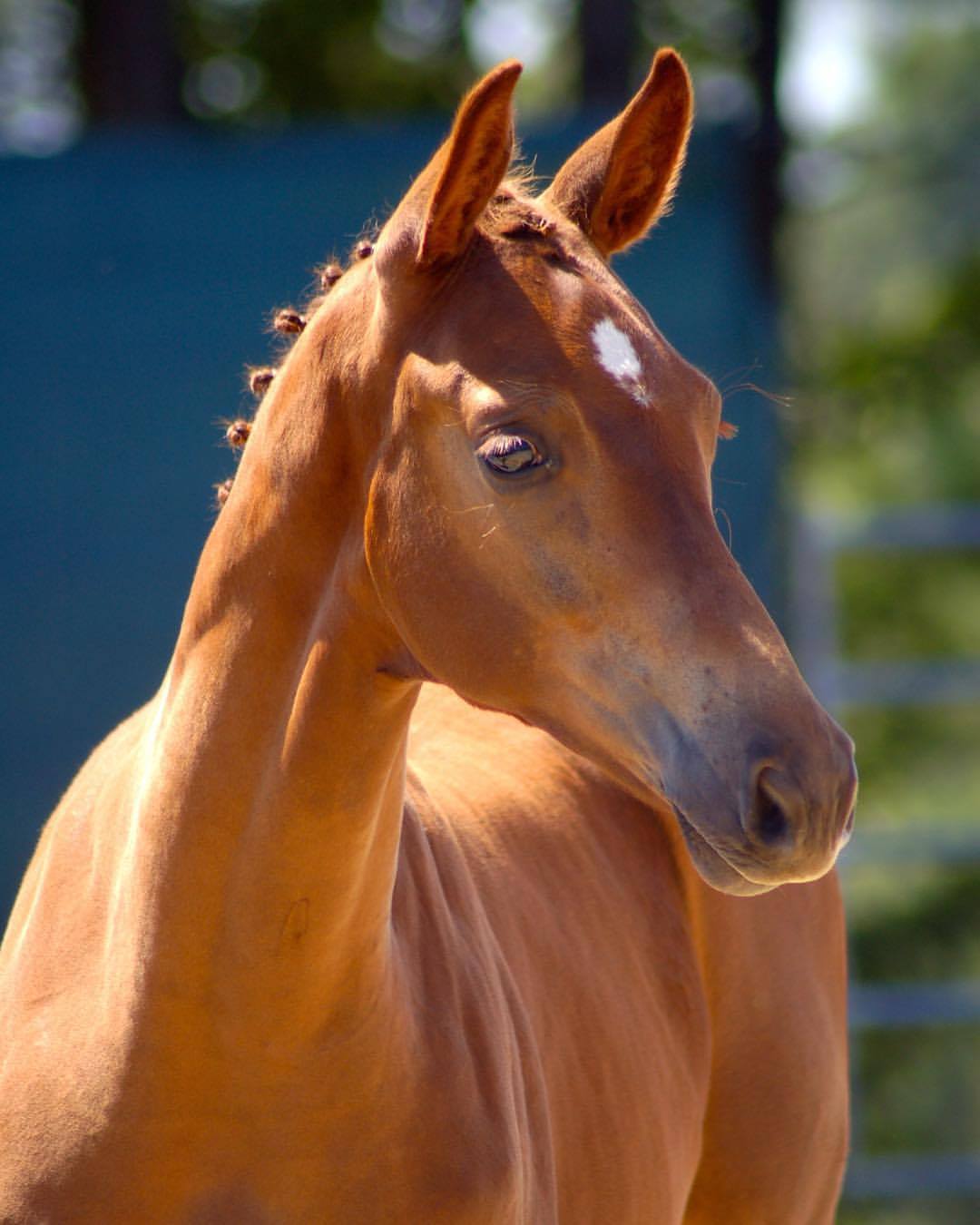
Foal
Stallion Activation
KWPN stallions in North America must be activated for breeding each year (this includes Foalbook stallions). There is an annual fee for the activation of a stallion. Approved stallions that are activated will have their own page in the Stallion Directory and Handbook, as well as a page on the website. Foalbook stallions that are activated will be listed in the Handbook.
Foals by KWPN stallions standing in North America that are not activated will not be eligible for KWPN registration.
Proof of EVA testing or vaccination is mandatory the first time a stallion is activated.
Reporting Breedings
Stallion owners/ agents are responsible for reporting all breeding information to the KWPN-NA office by December 1 of the breeding year. Breedings may be reported on the forms sent by the office or by e-mail in an Excel spreadsheet. Mare owners should send a copy of the mare’s registration paper to the stallion owner to ensure correct information. Reporting breeding information for mares bred with imported or outside semen is the responsibility of the breeder.
- Breeding to a KWPN Activated Stallion – The stallion owner or agent will report the breeding to the KWPN-NA office by December 1 of the breeding year. Breeders should report any changes of address that occur after the breeding took place so the birth declaration may be sent to the correct address.
- Breeding with Imported Frozen KWPN Semen – The breeder is responsible for reporting the breeding to the KWPN-NA office using the frozen semen insemination form that is available from the KWPN-NA website.
- Breeding with Outside Semen – The breeder is responsible for reporting the breeding to the KWPN-NA office using the appropriate fresh or frozen semen insemination from available from the Forms page of the website. When breeding to a new outside stallion it is advisable to talk to the KWPN-NA office first so that the breeder is aware of the registration possibilities for the resulting foal. DNA from the stallion must be available. Breeders should report any changes of address that occur after the breeding took place so the birth declaration may be sent to the correct address.
Multiple Breedings
If a mare was covered by more than one stallion, all dates and information should be reported. The birth date and DNA parentage verification will determine the correct sire of the foal.
Embryo Transplant
In order to register a foal from an embryo transplant there are several forms that must be completed by the attending veterinarian. The Insemination form, Embryo Transfer Verification Certificate and the Donor and Recipient Mare Identification forms are all available on the website and from the KWPN-NA office. These forms should be sent to the office after the recipient mare is checked in foal.
The foal’s parentage will be verified against its reported biological parents. A hair sample from the recipient mare should also be pulled and submitted to the KWPN-NA. It will not be tested, but kept on file, unless it is for some reason deemed necessary to test the sample.
Parentage verification will include the foal, the donor and the recipient mares, as well as the stallion. In the case of multiple foals from one mare, the DNA will be tested for individuality.
Parentage Verification
Parentage of all foals and horses with applications for duplicate papers must be verified through DNA done at the Genetics Lab at U.C. Davis. Due to problems with timeliness, parentage verification can no longer be done in Canada. There will be no exceptions. Both parents must have DNA on file. There are cases where it might be required that a recipient mare must be tested. Therefore pull mane hair from the recipient mare before she leaves your farm!!! As a safeguard for breeders with mares that do not yet have DNA on file, please pull hair from the mare prior to her giving birth. A DNA test for each foal is included in the cost of registration. In the case of a deceased stallion, a straw of frozen semen may be submitted for DNA testing. Additional DNA kits may be ordered separately for $60 each. Replacement DNA kits are $15.
To expedite registration, please include hair sample with birth declarations and application for duplicate papers. Pull 20–30 hairs with intact roots and put in an envelope. If you are submitting for a very young horse, please pull tail hairs.
Please put the hair in a Ziploc bag or paper envelope. Do not use Saran Wrap, the unwrapping damages the hair sample.
Stallion Service Certificates
The KWPN-NA Stallion Owners Committee has requested to do away with Stallion Service Certificates. Therefore, starting with foals born in 2014, the white copy of the Stallion Service Certificate will no longer be required to be sent in with the birth declaration when registering a foal.
Registration Possibilities
Because of its open studbook policy, foals by outside stallions or from outside mares can also be registered with the KWPN. Owners of KWPN mares that want to breed to outside stallions should check with the KWPN-NA office to see what the registration possibilities will be of the resulting foal. Owners of outside mares that want to breed to KWPN stallions should check with the KWPN-NA office to see what the registration possibilities will be of the resulting foal. A general outline of the status of foreign registries in North America is on page 14.
Breeder of a Horse on Registration Papers
In the history of the KWPN-NA (and the KWPN) the “Breeder of a Horse” was the owner of the mare at the time of birth. Starting 2014, the “Breeder of a Horse” will be the owner or lessor of the mare at the time the breeding takes place (the person making the breeding decision). This will include the breeder of foals imported in utero from Holland.
Equine Viral Arteritis
New EVA Protocol for Stallions
Any new breeding stallion (including Approved, Foalbook and newly imported stallions) must be tested for Equine Viral Arteritis prior to first his first breeding season. If the blood test is positive, a semen test must be done to determine if the stallion is a shedder. EVA testing will not be required for activation with the KWPN-NA after that initial test. Results will be published on the stallion’s page.
EVA Protocol as Recommended by the AAEP
Breeding stallions, first-time vaccinations – It is recommended a stallion with a negative blood test be vaccinated. Prior to initial vaccination, stallions must have their blood tested and be confirmed to be negative for antibodies. Testing should be performed shortly prior to the time of vaccination. A certification of a negative test result prior to vaccination is important in the case he is considered for export at a later date. All first-time vaccinated stallions should be isolated for 3 weeks following vaccination before being used for breeding.
Breeding stallions, previously vaccinated – Annual booster vaccinations against EVA are strongly recommended no earlier than 4 weeks prior to the start of the breeding season.
If a stallion is a shedder this fact will be published in the KWPN-NA Stallion Directory and Handbook. If there are other breeding stallions on the same property, they must be tested annually or proof of vaccination must be provided (initial negative test must be provided.)
In order to prevent the carrier (shedding) state, as well as to prevent EVA, colts under 270 days of age that are serologically negative for antibodies to EVA should be vaccinated. Written certification of their negative serological status should be obtained before vaccination occurs.
FAQs
This archive contains KWPN-NA Frequently Asked Questions (FAQs). Please choose from one of the questions listed below to view its answer.
How do I place a classifieds ad for my KWPN-NA horse?
A perk of membership to the KWPN-NA is the ability to list your KWPN-NA horses for sale on our Classifieds page. This allows your horse to be advertised to other KWPN-NA members that may be looking for another horse to add to their program.
Classifieds Page
We have created a Placing an Ad How-To to answer any questions you may have for creating an advertisement for your horse.
Placing an Ad How-To
Can I change the registered name of my Dutch horse?
Yes, you are able to change the registered name of your horse if the horse has no registered offspring. The new name MUST start with the assigned letter of the year, so the new name must start with the same letter as the original name.
You must be the owner of record to change a horse’s name. The form is on the Forms page of the website and the fee is $50. If the change is done at the time of a keuring or before a horse’s first set of papers is printed, there is no charge.
Forms Page
How do I get a passport for my horse?
You will need to contact the United States Equestrian Federation (USEF). You can download the passport application at:
USEF Passport Application
Where can I buy a KWPN horse?
The KWPN-NA does not make any recommendations for buying horses. However, horses are advertised in the ‘Marketplace’ section on the website. Both the ‘Links’ and the ‘Breeders’ Directory’ contain links to breeders and owners of horses, both in North America and the Netherlands. The KWPN-NA does not make any guarantees either expressed or implied in connection with ads or links.
KWPN Marketplace
Links
Breeder’s Directory
Does the KWPN-NA brand all horses?
No. Only horses age 3 and older that have successfully completed a studbook inspection are eligible for branding, and only if the owner so chooses. Geldings can only be branded if they receive the Ster predicate.
What happens at a keuring?
At a keuring there are classes for young horses (weanlings, yearlings and two year olds) as well as classes for adult horses. Studbook inspection classes are offered for horses 3 years and older and include an evaluation of conformation and movement or free-jumping. Stallions are evaluated for approval at select locations. There are also classes for young jumpers and young dressage horses.
How do I sign my horse up for a keuring?
Keuring entry information will be available on the website after the year’s keuring tour has been organized. The KWPN-NA also sends out entry booklets to all current members in mid to late April. Included is a description of classes as well as an entry form and liability release. It is important for the owners of mares born into the Register A book to inquire about any Keur/Elite requirements that may need to be completed.
Should I take my horse to a keuring?
Yes, if possible. The keuring system offers an evaluation of your horse against the standard for KWPN horses worldwide. Information is compiled on the keuring results, thereby providing feedback for breeders and the community at large on the success of various bloodlines and breeding choices. Mares and stallions can also receive “predicates” based on the quality of their offspring at keuringen. A keuring is an educational and marketing opportunity.
Why do I need to send in pictures of a newly imported horse?
The office needs to have photos on file in case your registration papers get lost or destroyed. If you need to apply for Duplicate papers it helps to have existing photographs of the horse on file for comparison. We also check the markings and compare them to the photos.
If I send in the KWPN (Dutch) papers, will I get them back?
When doing a transfer of ownership you will not receive back the original papers that you send in. The transfer will be completed in our database and a brand new set of papers with your name as owner on the back will be issued to you.
I just purchased a Dutch horse. Should I transfer the ownership?
Transferring ownership of your horse will provide an extra level of security for you and your horse. The papers identify the horse by markings and possibly by photos. As the new owner you will now have documentation (the registration papers with the transfer indicated) that you own the horse. In the unfortunate event that you lose the registration paper of your horse it will be much, much easier to apply for and receive duplicate registration papers.
Additionally you must be the owner of record of the horse in order to qualify for any sport or year-end awards.
How do I transfer the ownership of a horse into my name?
Transferring ownership of your horse will provide an extra level of security for you and your horse. The papers identify the horse by markings and possibly by photos. As the new owner you will now have documentation (the registration papers with the transfer indicated) that you own the horse. In the unfortunate event that you lose the registration paper of your horse it will be much, much easier to apply for and receive duplicate registration papers.
Additionally you must be the owner of record of the horse in order to qualify for any sport or year-end awards.
Does a Dutch horse have to be inspected in order to be registered?
No. Foals are registered in one of several “books” on the basis of their pedigree. A foal book registered foal is considered to be of good quality when it is the product of approved/licensed parents, worthy of papers documenting its good pedigree. At 3 years of age a horse can be presented for studbook.
What about naming my foal? Does the KWPN-NA allow duplication of names?
Each foal born in a given year must have a name not to exceed 20 characters or spaces and beginning with the designated letter for that year. For example, the designated letter for 2020 is “P”. All registered foals will have a unique registration number. The KWPN does not have a unique naming requirement except in the case of Approved stallions. Approved stallions must have a unique name and in some cases must be renamed.
How do I register a foal?
If your mare was bred to a KWPN-NA activated stallion, breeding information should already be sent to the KWPN-NA by the stallion owner/agent. If your mare was bred with imported, frozen semen or to an outside stallion, you will have the responsibility of reporting the breeding to the KWPN-NA. Forms to report your breeding are available on the website. From this information, the database will be updated and current members will be given their login information to our Member Portal where they can register their foal online. Hard copy foal birth declarations are also available upon request.
Foals may be registered by the Owner of Record of the mare or the Lessee of Record of the mare at the time of the birth. If the foal is sold before registration, the new owner must obtain the Birth Declaration from the mare owner and send it in along with a Bill of Sale from the Mare Owner of Record.
Registration papers will not be released until DNA verification is complete and the microchip affidavit is returned.
What do I need for a Transfer of Ownership?
To transfer ownership on a horse you will need:
- A Transfer of Ownership form (found on the KWPN-NA website.)
- Original Registration Papers. No copies of registration papers are accepted. Originals only!
- A copy of your Bill of Sale.*
- The passport if the horse was issued one
Photos: If an imported horse is being transferred to a North American owner for the first time, three photos (clearly showing all markings) are also required.
* Bill of Sale:
- If you buy the horse from someone other than the owner listed on the papers, you will need a clear paper trail going back to the owner of record listed on the registration papers.
- In the case of a first-time transfer on a horse imported from Holland, the paper trail needs to go back to the owner or their agent in Holland.
- The paper trail may consist of a signed bill of sale, a simple release of ownership, consecutive signatures in a passport, copies wire transfers to the owner of record, etc.
- With a bill of sale signed by the owner of record with the KWPN or KWPN-NA, you do not need the owner’s signature on the transfer form.
- If none of this is available, please submit an Ownership Affidavit (avail. on the forms page) along with your transfer
What are the benefits of joining the KWPN-NA?
Members will receive eNewsletters and are eligible to register horses, transfer horses and participate in a Keuring. Members are also eligible for horse show awards and year-end sport awards; are eligible to vote; are eligible to take part in the Stallion Service Auction; and are eligible to attend the Annual Meeting and other educational activities.
How do I join the KWPN-NA?
A membership form is available on the website, or you can return the Renewal form mailed by the KWPN-NA office. There is also an option to renew via the login page of our Member Portal linked at the top left corner of our page. The member year runs from January 1–December 31 and includes the award program and a quarterly newsletter. Rates are $850 for a lifetime membership, $85 for a full membership, $50 for an associate membership and $35 for a youth membership. The KWPN-NA accepts checks (in US funds), Visa, Discover or MasterCard.
Full membership is required for registering horses and transferring ownership at the member rate. Associate and Youth memberships will allow you to participate in year-end awards programs.
Membership Form
What does KWPN stand for?
KWPN stands for Koninkijk Warmbloed Paardenstamboek van Nederland, which translates to Royal Warmblood Horse Studbook of the Netherlands. KWPN-NA stands for KWPN of North America.
Disclaimer: The KWPN-NA reserves the right to refuse service. There will be no refunds on registration fees after DNA samples have been submitted to the lab.

